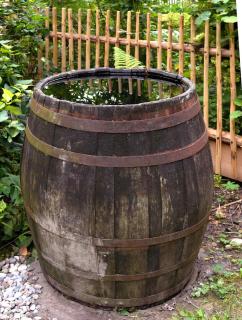

Wondering about harvesting rainwater for the garden? Apart from the usual environmental and ethical considerations that may drive you to find something better than tap water to water the garden, there’s also that simple reality check we sometimes overlook: your wallet!
Indeed, tap water as provided by utilities tends to be quite expensive, and prices are trending upwards. Furthermore, additives like chlorine or fluoride are bad for plants.
Using rainwater for all the needs of the garden is actually an excellent choice to reduce the water bill.
But how to proceed and how much should this cost?
Consider the following to see if watering with rainwater is a good idea for you:
Using rainwater for the garden is a possibility, but the first question to come to mind is “how much will I save?”
According to a European environmental agency (ADEME), watering the garden consumes 10 quarts (10 liters) of water per square yard (meter) on average.
Let’s do the math. If your garden is 100 square yards (meters), you’ll be using 1,000 liters of water which is 1 cubic meter or yard – per watering session!
Multiply that with the average cost for a cubic meter in your area. In France, it’s 3€ for example. So every time you water, you spend 3 bucks (€ or $). And that’s only an average! Check how much space you’ve got in your yard and you’ll see how much of an incentive that is to stop wasting drinking water in the garden…

Setting up a tank to collect rainwater comes with a different price tag depending on whether you only intend to use it for the garden, or whether you hope to use it for the house, too. If you want a large-scale buried cement tank that will cover the needs of the garden and all the gray water in the house (toilets, laundry, etc), the price tag is a bit high. Expect up to 10,000 dollars or euros, but often some of this is tax-deductible depending on local or national ordinances.
If however your ambition will settle with simply gathering rainwater for the garden, simple tarpaulins with a wooden or plastic structure will do the trick. For these low-end options, prices are rock-bottom, since the cheapest start at around 20 dollars or euros. Take note though, that these small containers are only adequate for areas where rain is frequent: they can’t contain much water.
Again, you’ve got several options here. The easiest solution is to locate your small water tank under the gutter pipe from your roof. Simply remember to prepare some kind of stand to rest it upon, like hollow blocks, because you’ll have a hard time filling your watering can if the faucet is at ground level…
It’s also possible to pair multiple tanks together, and connect them all to the rainwater pipes. All in all, expect to spend about 40 to 50 euros or dollars per tank and half as much for the piping and fittings. Take a little extra fittings or tubes if ever you plan to connect the pipes to the gutter directly.
Smart tip #1: if you’ve got a nearby garage or parking shed near your house, place the water tanks between both buildings: you’ll be able to drain the water from both roofs.
Smart tip #2: for those who don’t want to spend their gardening hours dredging a watering can back and forth, purchase a little pump which you can connect to your watering hose.
In a way, yes. Indeed, although average rainfall might be the same over a year for two different locations, sometimes the span of time between rains and the volume of water falling from the sky follow very different patterns.
For example, in Southern France, rainfall for the entire year is concentrated on two short months (one in spring and one in fall), whereas in Central France, rainfall is evenly distributed to every month of the year.
The consequence here is that if the rainfall is very regular, as in Central France, a small tank will do. But if long spans of time must be covered between two subsequent rainfalls, then the water tank you’ll need must be larger.
Check with your local weather office, they’ll be able to show you simple charts with average rainfall one month at a time. This will help you plan your purchase well – and avoid frustration!